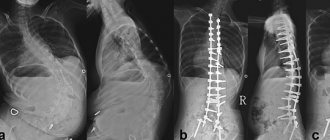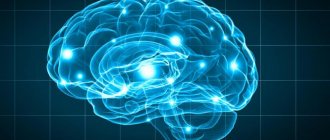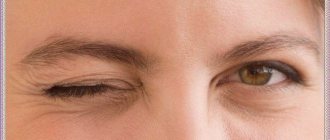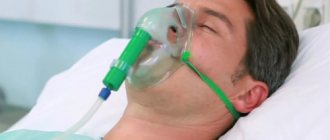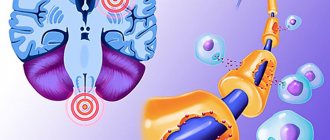Neurotic disorders occupy a leading place in the structure of mental illnesses. The prevalence of psychogenic neurotic disorders necessitates constant improvement of their diagnosis, therapy and prevention. Often, patients with neurotic disorders seek specialized help from neurologists and general practitioners.
At the Yusupov Hospital, this category of patients is treated by experienced psychotherapists who have specialized in leading European clinics and are fluent in psychotherapeutic techniques, including cognitive behavioral therapy. Medical staff treats patients' problems with respect.
ICD 10 code
Stress-related and somatoform neurotic disorders in ICD 10 are classified in categories F40-F48. Neurosis is a disease with reversible mental disorders. The disease is caused by exposure to traumatic factors. Neurotic disorder is characterized by the presence of the following symptoms:
- disturbances of well-being, somato-vegetative, emotional functions;
- mental exhaustion;
- the patient’s awareness of the fact of his illness;
- absence of disruption of the reflection of the real world.
Psychiatrists distinguish the following clinical forms of neurotic conditions: asthenic neurosis (astheno-neurotic disorder or neurasthenia), obsessive-compulsive neurosis, hysterical neurosis, neurotic depression (depressive neurosis).
Types of neuroses and forms of their manifestation
Doctors distinguish several types of neuroses. We can highlight the following:
- bulimic. It is characterized by uncontrolled absorption of unhealthy, fatty and high-calorie foods. This species is more common among males than females. People with low self-esteem who are accustomed to eating away at their problems suffer from it;
- depressive. Neurosis of this type manifests itself in a decline in a person’s strength and mood, as well as stagnation of intellectual development. The main symptoms of the disease: the patient’s inability to rejoice, bad mood, disrupted sleep patterns and insomnia;
- neurasthenia. Severe neurosis, characterized by depression and fatigue. The symptoms of its manifestation include the following: dizziness, headache, vulnerability, difficulty concentrating on anything. There are two stages of neurasthenia: the first, where irritability appears, and the second, where performance slows down and apathy appears;
- hysterical neurosis. Its cause is lack of attention and low self-esteem. All this leads to feigned behavior. This species is characterized by vomiting, a feeling of a lump in the throat, and seizures. People suffering from hysterical neurosis tend to be irritable even in the most peaceful surroundings. Their behavior cannot be predicted;
- alarming. The person feels constant fear. He is afraid of finding himself in a situation that seems hopeless. Or he is also afraid of getting sick with some serious and complex illness. Hysteria is one of the common signs of anxiety neurosis.
Causes
The formation of neurotic disorders is provoked by the influence of many factors. This may be a short-term reactor or chronic stress. Currently, there are two main causes of neuroses:
- insufficient functionality of the body's neurotransmitter and neurophysiological systems, which leads to a pronounced response to stress;
- mental characteristics, personality type and relationships with other people.
- The most common causes for the development of neurological disorders are:
- long-term illnesses, especially those accompanied by intoxication;
- addiction to drinking alcohol or smoking tobacco;
- chronic or acute stress: death or serious illness of a loved one, divorce, dismissal;
- mental overload;
- influence of family and others. Children adopt the habits and behavior of their parents; if the mother or father behaves aggressively, there is a high probability of neurotic disorders in the child.
Risk factors
Although there are many manifestations of this disease, what they have in common is a stress factor or a traumatic situation. These can be difficult experiences, stress, strong excitement, emotional turmoil.
Video 1. What is neurosis? Source: YouTube channel “TASS Science”
However, constant stressful situations are not a necessary risk factor. Among the potential “victims” of neuroses are people with an unstable psyche that reacts sharply to an atypical situation. For suspicious, impressionable, sentimental people, one strong shock is enough. For example, for a woman it may be a difficult birth. The disease can be provoked by:
- loss of a large sum of money;
- difficult divorce proceedings;
- separation from a loved one;
- dismissal;
- disaster, accident;
- death of a loved one.
star fever
People leading an active public lifestyle are susceptible to neurosis. Johnny Depp, Emma Stone, Bella Hadid, David Beckham, Mariah Carey are just a small part of the list of show business stars who have publicly admitted to treating neurosis. For 12-year-old Prince Harry, the death of his mother, Princess Diana, was a stress factor for protracted neurosis. For Ariana Grande - the terrorist attack in Manchester. The world-famous singer Adele experiences fear in front of a large audience. And actress Kim Bassinger suffers from panic attacks.
Classification
The main types of neurosis include:
- Neurasthenia. Develops against the background of difficulties in interpersonal relationships. It is also called “irritable weakness”, such people show dissatisfaction with any reason, they are bothered by headaches and heart pain, tachycardia, heartburn and sleep disturbances;
- Hysteria or conversion neurosis. It is observed more often in females. Such people play along with the created image. Often this is the role of a seriously ill patient, simulating seizures or loss of vision. An attack of hysteria occurs spontaneously, usually after a provoking situation, in order to get what is what. However, the symptoms do not appear at the request of the patient and leave him tormented. Hysteria is observed in spoiled people and people with high self-esteem who are not accustomed to being denied anything;
- Obsessive-compulsive neurosis. The condition manifests itself through the emergence of fear and anxious thoughts even in the absence of a provoking agent. These include fear of society, fear of infection with some kind of disease. To alleviate their condition, patients may resort to special rituals that cause inconvenience and suffering. This group includes phobic neurosis and panic attacks;
- Somatoform disorders. This is the name given to the appearance of complaints that resemble a somatic disease, but no organ pathology is objectively detected.
- This group of neuroses is classified as general, in the clinic of which emotional disorders predominate.
- According to the duration of their course, neuroses are divided into:
- Spicy. They develop in response to short-term stimuli and can go away on their own, without specific therapy. This type of neurosis is also called situational;
- Chronic. They arise under the influence of a long-term stimulus, leading to disadaptation in society and changes in the psycho-emotional background.
- Other types of neurotic disorders:
- Bulimia is an eating disorder. It often occurs in teenage girls with complexes and lack of self-confidence. There are two forms of bulimic neurosis: with and without purging. In the first case, a person periodically overeats, then artificially induces vomiting so as not to gain weight. People suffering from bulimia without purging exhaust their bodies with strict diets and excessive exercise;
- Hypochondriacal neurosis is classified as a somatoform disorder. Such people concentrate their attention even on minor deteriorations in their well-being. They regard any symptoms as a sign of a dangerous disease. Such people usually come to the doctor with a stack of reports from other specialists and the results of many examinations. The diagnosis is made by excluding somatic pathology based on examination data, treatment is carried out by a psychotherapist;
- Autonomic neurotic disorder or VSD is a complex of symptoms caused by dysfunction of the sympathetic and parasympathetic nervous system. Depending on the predominance of the tone of the nervous system, VSD can occur as sympathicotonia or vagotonia. In the first case, symptoms of activation of the sympathetic nervous system (increased blood pressure, tachycardia, pallor) dominate, in the second - parasympathetic (low blood pressure, slow pulse, dizziness, redness of the skin). A separate category is vegetative crisis, which is characterized by increased symptoms and is accompanied by dizziness, weakness, sweating and decreased blood pressure. Against the background of an imbalance in the functioning of the nervous system, muscular or respiratory neurosis may occur;
- Noogenic neurosis has recently become increasingly widespread due to a sedentary lifestyle and the emergence of a virtual network. At the same time, a person loses his life values and regards his existence as meaningless, he has no incentive to work, he is not satisfied with his life and is unable to overcome life’s difficulties;
- Neurogenic bladder syndrome is a neurosis characterized by a fear of voiding in a public place. Such a person takes a long time to adjust to urination, eventually avoids leaving the house, and tries to drink less liquid in a public place;
- Cardioneurosis or cardiac neurosis is a disorder of cardiac activity in response to a mental disorder. A person feels a “fading” heart, pain in the chest, attacks of palpitations or pulsations throughout the body. During an attack, a person is bothered by a feeling of fear and anxiety. After ruling out cardiac pathology, such patients are prescribed a consultation with a psychotherapist;
- Sexual neurosis is a mental disorder that affects a person’s sex life. Sexual disorders are manifested by either an increase or decrease in sexual desire. With increased desire, sexual desire is directed towards another object, and sexual perversion occurs. A decrease in desire leads to the fact that a person avoids sexual contacts, and sometimes even people of the opposite sex;
- Obsessive-compulsive disorder is characterized by the presence of intrusive thoughts (obsessions) and actions (compulsions).
- There is alcoholic neurosis, which occurs against the background of severe alcohol dependence and can become chronic. Symptoms of this condition vary and may include insomnia, fatigue, aggression or depression, headaches and heart pain. The main goal of treatment is to get rid of addiction.
What are the symptoms of professional neurosis?
There are “first signs” that you definitely need to pay attention to:
- Increased irritability, frequent and severe mood swings.
- Constant severe fatigue.
- There is no satisfaction from work, I often want to “give up everything.”
- Bad dream. I can’t sleep at night, but I want to sleep during the day.
- Violation of relationships with colleagues, friends, family.
- Headache.
- Chest pain.
- Feeling short of air.
- My head is constantly spinning with thoughts about work, unfinished projects, fears about possible dismissal or other negative events.
- After sleep there is no feeling of vigor, you still feel weak.
- It becomes difficult to maintain the same pace of life. It takes more time to do things and make decisions, fatigue sets in faster, and you constantly want to be distracted, lie down and relax.
Symptoms
In patients with neurosis, two groups of symptoms are distinguished:
- Somatic. They arise as a result of uncoordinated work of the sympathetic and parasympathetic nervous systems. In this case, the person has complaints about his health, but there is no pathology of the internal organs;
- Psychological symptoms are different for different types of neurosis.
Somatic symptoms Neurosis can be suspected if the following symptoms are present:
- increase or decrease in blood pressure;
- tinnitus, hand tremors;
- insomnia;
- decreased concentration, memory impairment;
- tachycardia or bradycardia;
- muscle pain, twitching, even cramps;
- nausea, vomiting;
- increased or decreased appetite;
- unsteadiness of gait;
- pain in the left side of the chest;
- difficulty urinating;
- increased sweating;
- tingling sensation, numbness in the limbs, changes in sensitivity in various parts of the body;
- gastrointestinal disorders: constipation, diarrhea;
- trembling in the body;
- headache;
- feeling of pulsation in various parts of the body;
- darkening of the eyes;
- stomach ache;
- decreased potency;
- pale or red skin;
- feeling of lack of air when breathing;
- skin rashes, scratching, burning.
When the first symptoms appear, patients go to the hospital and only after a long examination and consultations with various specialists do they see a psychiatrist.
Prolonged absence of diagnosis leads to increased severity of symptoms and the transition of the disease to a chronic form. The Yusupov Hospital employs specialists of the highest category with scientific degrees and extensive experience in treating neurotic disorders.
Make an appointment
Psychological The presence of psychological symptoms indicates that with neurosis there is a disorder of the psycho-emotional sphere. Signs of a neurotic disorder include:
- Decreased self-esteem. A person in a state of neurosis is indecisive in his actions, avoids crowds of people;
- Irritability. Any difficulties and situations provoke a violent reaction, anger, aggression, hysteria;
- Touchiness. A neurotic takes any criticism literally;
- Depression. The state of neurosis leads to a constantly depressed mood, lack of desires and drives, up to complete apathy and self-deprecation;
- Self-criticism. Neurotics treat even the slightest shortcomings strictly;
- Anxiety. Such people are constantly afraid of something, especially with regard to obsessive-compulsive disorder. Sometimes panic attacks can occur - an attack of anxiety and fear, accompanied by somatic symptoms;
- Instability of the emotional background is a change in mood, either for the good or for the bad, for no apparent reason. A bad mood can manifest itself as tearfulness and powerlessness for no reason;
- Difficulty communicating with other people. The state of neurosis provokes the emergence of internal conflict and alienation from the outside world.
Symptoms of neurosis in men and women Signs of a neurotic disorder in men may include disturbances in sexual desire and sexual function.
The stronger sex is more likely to experience depression due to lack of fulfillment and lack of work. Hysterical neuroses are more typical for women. This condition is often accompanied by severe somatic complaints. Typically, this condition occurs in people with a demonstrative personality type, when trying to attract attention.
Why does the disease develop?
The World Health Organization notes that 10-20% of the world's population is diagnosed with various neurotic disorders. However, these are only officially confirmed diagnoses. Many more people live with their fears and anxieties for years without seeking medical help.
Among the common reasons:
- constant overwork;
- information overload;
- monotonous work;
- features of upbringing in a family with frequent traumatic situations;
- asthenic physique;
- long-term chronic diseases;
- frequent drinking of alcohol.
Psychologists say that individual characteristics of the psyche and physiology are of great importance. People with different character types may experience the same situations differently. For example, some perceive monotonous work as normal, while others perceive it as stress.
Neurosis in women is observed 2 times more often than in men. The explanation is the so-called emotional lability (instability, mobility). Women enter a state of passion much more easily when exposed to even weak external stimuli (events, situations).
Women experience neurosis more often than men. Photo by Andrea Piacquadio from Pexels
Signs of other psychogenic neurotic disorders
Obsessive-compulsive neurosis actually includes obsessions (obsessions) and phobias (obsessive fears).
Obsessive disorders are represented by obsessive thoughts that are stereotypically repeated and extremely painful for the patient. Compulsions are repeated behaviors that purport to prevent harmful or dangerous events that are extremely unlikely to occur. The patient is formally critical of ritual actions, but cannot overcome them on his own. Phobic disorders include fear of certain situations. The patient is critical of his own phobic experiences, understands their alienness, strives to overcome them, but cannot free himself from them. The following obsessive fears are encountered:
- Agoraphobia is a persistent fear of being in crowds of people, fear of public places (workplaces, shops, streets, open squares, theaters, concert halls), and independent long trips on various types of transport;
- Claustrophobia – fear of closed spaces;
- Thanatophobia – fear of death;
- Cancerophobia – fear of cancer;
- Cardiophobia is the fear of severe heart disease.
Hysterical neurosis includes conditions that arise in patients with an obvious or objectively proven conflict situation (violation of interpersonal relationships, insoluble problems), even if the patient denies it.
More often, such conditions arise and stop suddenly. Some of them (anaesthesia and paralysis) gradually develop and persist for a long time. There is no connection between the mental disorder and neurological or physical disorders. The “benefits” for the patient and the clearly psychogenic nature of the disorders raise suspicions about attitudinal behavior. These specific psychopathological manifestations are disease states with specific pathogenetic mechanisms. Hysterical amnesia is manifested by impaired memory for recent stressful events, accompanied by depressive feelings. Memory loss is often partial. It is not caused by intoxication or organic brain damage.
Hysterical movement disorders reflect the patient’s subjective ideas about an alleged neurological disease, but the nature of the complaints does not correspond to real organic disorders. The presence of movement disorders allows the patient to avoid a difficult psychotraumatic situation. The intensity of the manifestation of disorders is closely related to the number of people who are present near the patient. Patients use the violations themselves to attract the attention of others.
Hysterical neurosis can be manifested by the following motor disorders:
- convulsive seizures;
- paralysis (complete and partial);
- hyperkinesis (excessive violent motor acts that occur against the patient’s will);
- contractures (stiffness of joints);
- mutism (a condition when the patient does not answer questions and does not even make it clear that he hears them);
- hysterical stupor (depressed mental state, manifested in silence, inhibition, inactivity).
The patient may experience convulsions similar to epileptic seizures.
All these disorders are not caused by organic damage to the organ or other disease. There are no signs such as tongue biting, involuntary urination, consequences of sudden falls, or loss of consciousness. Sensory disturbances during hysteria are manifested by a variety of sensitivity disorders:
- anesthesia (loss of sensitivity to pain);
- hyposthesia (decreased pain sensitivity);
- hyperesthesia (increased pain sensitivity);
- paresthesia (sensation of itching, burning, crawling).
Sensory disturbances often correspond to areas of innervation.
Patients experience bright, unusual hysterical pains. There is loss of hearing and vision. Depressive neurosis is a condition that is determined by the depressive triad: decreased mood, mental and motor retardation. Symptoms of the disease are moderately expressed, affect the patient’s behavior, but allow the individual to maintain social adaptation. Patients' ability to concentrate and self-esteem decreases. Night sleep disturbances and anxiety are typical.
Make an appointment
Causes and mechanisms of development of respiratory tract neurosis
The main cause of respiratory neurosis is anxiety, anxiety-depressive disorders, and less often - hysterical. Mental disorders disrupt normal breathing and lead to increased ventilation. The respiratory system has not only a high degree of autonomy, but also a high degree of learning ability, and a close connection with the emotional state, especially anxiety. It is extremely rare that the cause of respiratory neurosis is organic somatic neurological and somatic diseases - pulmonary, cardiovascular and endocrine.
When breathing is impaired, complex biochemical changes occur, especially in the calcium-magnesium balance system. Violation of the mineral balance leads to an imbalance of respiratory enzymes and contributes to the development of hyperventilation.
The habit of breathing incorrectly is formed in a person under the influence of cultural factors, past life experiences, and stressful situations suffered in childhood. Children often witness dramatic manifestations of attacks of bronchial asthma and diseases of the cardiovascular system. Patients suffering from respiratory neurosis have often experienced increased stress on the respiratory system in the past: swimming, running, playing wind instruments.
The mechanism of development of neurosis of the respiratory system is multi-level and multidimensional. Anxiety disrupts normal breathing. As a result, ventilation is enhanced. An increase in pulmonary and alveolar ventilation leads to the following biochemical changes:
- Excessive release of carbon dioxide from the body;
- The development of hypocapnia (increased carbon dioxide tension in arterial blood and body tissues) with a decrease in the partial pressure of co2 in the alveolar air and oxygen in the arterial blood;
- Respiratory alkalosis (a disorder of the acid-base balance of the body, which is characterized by an absolute or relative excess of bases).
These shifts contribute to the formation of pathological symptoms: impaired consciousness, function of the autonomic system, muscle-tonic, pain, and sensory disorders. As a result, mental disorders intensify and a pathological circle is formed.
Diagnostics
Only a highly qualified specialist can diagnose neurosis, since the symptoms are very nonspecific. This may require consultation with doctors of various specialties:
- therapist;
- endocrinologist;
- gastroenterologist;
- cardiologist;
- neurologist.
Before scheduling a consultation with a psychiatrist, the patient is prescribed an examination. Taking into account the complaints, the doctor selects the necessary studies:
- MRI, CT;
- Ultrasound of the thyroid gland, genital organs;
- ECG;
- Echocardiography;
- Fibrogastroduodenoscopy.
Early diagnosis makes it possible to treat neurotic disorders in the early stages.
The Yusupov Hospital has its own diagnostic center with modern equipment of European quality. Doctors at our clinic regularly attend conferences, receive scientific titles and master new treatment methods. When diagnosing neurosis, differential diagnosis is carried out with other diseases:
- enteritis, gastritis;
- psychopathy;
- angina pectoris;
- hypothyroidism;
- adrenal tumor.
The main difference between neurotic disorders and somatic pathology is that as a result of examinations of internal organs, no deviations from the norm are observed. To confirm neurosis, special psychological tests are carried out: anxiety, the Zung and Beck depression test, the K. Leonhard questionnaire.
Types of anxiety-phobic disorder
Currently, more than five hundred phobias have been studied. Experts have divided them into three broad groups: specific (simple), social phobias, and agoraphobia.
Simple phobias
These include fear of an action, situation, or object. This could be a fear of the dark, certain animals (dogs, spiders, snakes, insects), openings, air travel, darkness, enclosed spaces, blood, heights, disease, etc.
As a rule, such absurd fears develop in a small child during the period when he begins to explore the world. For some people they disappear as they grow up, while for others they remain for the rest of their lives.
Social phobias
People suffering from them are afraid of attention from others and negative evaluation of what they do. Therefore, such individuals try to avoid public speaking, being in society, parties, crowded places, answering at the blackboard at school or university, calling unfamiliar subscribers, etc. This phobia usually develops during adolescence.
Social phobes fear that outsiders will seem ridiculous, inadequate, and strange. They are also concerned about their own reaction to anxiety: voice trembling, facial flushing, hand trembling, nausea.
Agoraphobia
This is the fear of being in a situation from which it is difficult to get out or where help cannot be provided in a timely manner. It appears in people after 20 years of age.
Agarophobes are afraid to go to a store, theater, cinema, travel in public transport, a car and an elevator, be left alone in an apartment, be away from home, in open spaces. As the disorder progresses, it expands its boundaries, that is, there are more and more disturbing situations, and as a result, the person, trying to avoid them, becomes a recluse.
In addition to phobias, anxiety-phobic disorders include pathologies that have pronounced behavioral and cognitive symptoms, with a strong reaction of the body to fear.
- panic attacks;
- generalized anxiety disorder;
- attacks of the Da Costa syndrome type.
Treatment
Treatment of neurosis has two main directions:
- medicinal;
- psychotherapeutic.
Usually, for complete recovery, only psychotherapy is sufficient, but if this method is ineffective, drug treatment is required. Psychotherapy For neurosis, psychotherapy makes it possible to find the cause of the disorder and choose the most effective method of therapy. The following areas of psychotherapy are used to treat neurosis:
- Cognitive behavioral therapy allows you to learn to identify and manage negative thoughts, discover and change beliefs that cause maladjustment in the environment;
- Art therapy is aimed at the patient mastering various types of art: dancing, drawing, modeling, music. In the process of training, a person masters new possibilities, and this also allows him to throw out his emotions and negativity. This allows you to relax and take your mind off problems and get rid of complexes. With the help of art, a person gets to know himself, discovers new abilities, which is very important in the treatment of neurotic disorders. Art therapy is also used to diagnose mental disorders. In the process of sculpting or drawing, a person involuntarily projects his thoughts and emotions, which helps to identify hidden aggression and a depressive state;
- Psychoanalysis is a treatment method in which, based on associations, fantasies and dreams, the doctor can determine the presence of an internal conflict. With its help, the instinctive behavior of a person, drives and desires at the level of consciousness and the unconscious are studied;
- With the help of Gestalt therapy, a person acquires the ability to make decisions independently and control their behavior.
- Psychotherapy improves the patient’s general condition and normalizes the emotional background. Getting rid of anxiety, depression, fears and phobias in most cases is only possible with the help of treatment from a psychiatrist. Explanation of behavior and identification of the provoking agent is the basis of therapy for psychoneurosis. In addition to a psychiatrist, sessions with a psychologist can help. At your appointment, you will be able to learn relaxation techniques that will help you overcome stress.
Make an appointment
Drug treatment Despite the high effectiveness of psychotherapy, it does not always allow you to completely get rid of neurosis. Drug treatment of neurotic disorders involves normalizing the function of the nervous system and enhancing the effect of treatment by a psychotherapist. In pharmacotherapy, the following groups of drugs are used:
- Sedatives are used as a remedy for mild neurosis. They have a calming effect and reduce emotional stress. They practically do not cause side effects and addiction;
- Tranquilizers have an anti-anxiety effect and a strong sedative effect. They reduce fear, anxiety, eliminate obsessive thoughts and actions;
- Antidepressants normalize the levels of serotonin, dopamine and norepinephrine. They improve mood, have virtually no side effects and are highly effective, especially in people with hypothymia;
- General strengthening treatment is achieved by taking vitamins B, A, D, E and antioxidants.
Other commonly used treatments include:
- Massage for neurosis can be acupressure or individual segments. It increases blood circulation, improves skin nutrition, relieves muscle spasms;
- Physiotherapeutic procedures such as inductothermy, electrophoresis, galvanization and electrosleep help improve overall well-being and normalize mood.
What is neurosis
The concept appeared in 1776 thanks to the Scottish doctor William Cullen.
Now in many countries this term is considered obsolete and the term “neurotic disorder” is used instead. He never came up with an unambiguous definition. Neurosis refers to a large group of mental disorders of the psychogenic type, that is, those arising under the influence of mental processes. Unfavorable situations and events cause an excessive reaction of the nervous system and disruption of brain activity. The famous physiologist Ivan Pavlov described the process of the onset of the disease as a chronic disorder of higher nervous activity that lasts for a long time. The problem is caused by overstrain of nervous processes in the cerebral cortex due to strong external stimuli.
Prognosis and prevention
Many people wonder how to live with neurosis.
The prognosis depends on the stage of development, type of disorder, timely detection and initiation of treatment. A significant improvement in the condition is observed with an integrated approach and a combination of medication and psychological assistance. Timely identification of the disorder guarantees the success of treatment, therefore, if you have symptoms of neurosis, you should immediately consult a doctor. Preventive measures to prevent neuroses and their relapses include:
- proper nutrition with sufficient fruits and vegetables will cover the body’s need for vitamins and minerals;
- a favorable atmosphere in the team and at home helps to improve vitality and strengthen the nervous system;
- getting rid of bad habits;
- healthy sleep and rest;
- regular walks in the fresh air;
- playing sports is one of the main ways to combat depression.
High modern standards are the basis for providing quality customer service at the Yusupov Hospital.
To schedule a consultation, call or leave a request on the website, and we will call you back. Make an appointment
How to prevent it?
The tips presented below relate to both the prevention and treatment of neurosis. So, in order to maintain the health of the nervous system, you need:
- Get more rest. And be sure to get a good night's sleep.
- Eat well, eat on time and as expected, and not on the go.
- Workout.
- Take up a hobby. It doesn’t matter what it is: the main thing is that it brings pleasure.
And the main advice: do not overload yourself at work, do not try to achieve everything at once. A healthy, emotionally balanced person will always achieve more over time and with fewer losses. And employers should know that an overworked, overworked employee always has a decrease in productivity, and this does not have the best effect on the work of the entire company. Sometimes this is even fraught with emergency situations and work-related injuries.
Annual medical examinations help you pay attention to your health in a timely manner. At the ProfMedLab clinic you can undergo a preventive examination, get advice and help from a good doctor. Contact us: +7 (495) 120-08-07.
Text: Artem Kabanov
